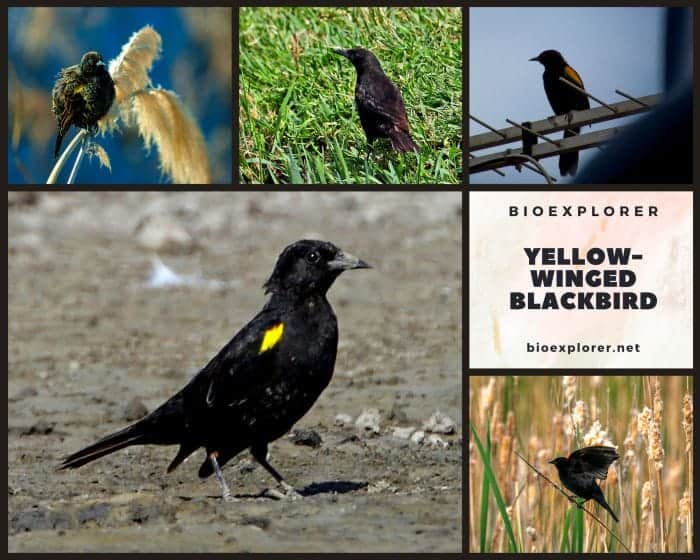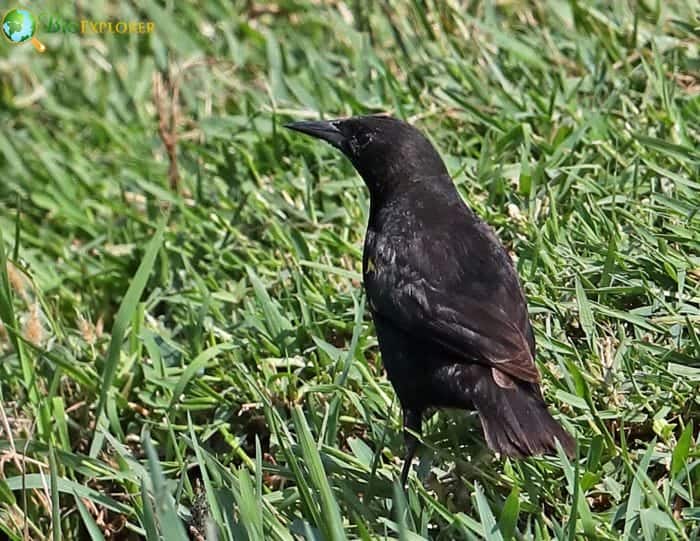
| Animalia | Aves | Passeriformes | Icteridae | Chordata | Agelasticus thilius |
The yellow-winged blackbird (Agelasticus thilius) is a medium-sized songbird across much of South America[1]. Males are jet black with bright yellow shoulder patches, while females are streaky brown. These sociable blackbirds thrive in grasslands and wetlands, where they forage on insects and seeds.
Table of Contents
- Yellow-winged Blackbird Identification and Physical Features
- Yellow-winged Blackbird Diet and Feeding
- Breeding Behavior and Nesting of Yellow-winged Blackbird
- Yellow-winged Blackbird Habitat and Range
- Conservation Status
- Where To See Yellow-winged Blackbirds?
- Fun Facts about Yellow-winged Blackbirds
- Conclusion
Yellow-winged Blackbird Identification and Physical Features

The yellow-winged blackbird gets its name from the striking yellow patches on the males’ wings. These contrast against otherwise all-black plumage. Females lack the yellow wings and are brown with darker streaking.
They are stocky blackbirds with short tails and thick conical bills suited for eating seeds. Identifying features include:
- Pointed bill for cracking seeds.
- Yellow shoulder patches on the wings of males.
- Females are brown with streaking.
- Short notched tail
- Walk with a characteristic hunch-backed posture.
Yellow-wings measure 16–20 cm (6.3 to 7.9 in) long with a wingspan of 30 cm (12 in). Males weigh 45 to 60 g (1.6 to 2.1 oz), while females are 35 to 45 g (1.2 to 1.6 oz).
Juveniles have tan-brown plumage with spotting on the throat and breast. Their wings show a mix of black and brown feathers. After their first spring molt, males acquire more yellow-colored feathers on the wings.
Male’s Bright Yellow Wings
The male’s flashy yellow wings and wing linings are important in territorial displays and mate attraction. This bright coloration communicates health, status, and fitness to other males and potential mates.
The vibrant yellow hue comes from carotenoid pigments obtained through the diet. Xanthophylls and lutein are yellow carotenoids common in grass seeds and other plant materials eaten by yellow-wings.
After ingesting plant foods containing these pigments, the xanthophylls are absorbed into the bloodstream and deposited into growing feathers. Selective deposition into certain feather tracts results in striking yellow patches contrasted against black.
The shade can range from pale Lemon to a deeper golden tone depending on what specific carotenoids are ingested. Older males tend to have richer, more vibrant colors. Diet quantity and quality while molting also strongly affect coloration.
Once the feathers grow, the yellow hue persists until the next molt since carotenoids are fixed into the keratin structure. However, the bright color does fade slightly around the feather edges between molts.
While female and juvenile yellow-wings also ingest carotenoids, they do not preferentially deposit them into their wing feathers. This results in their more subdued brown and tan plumage, providing camouflage for nesting duties.
By selectively utilizing carotenoid pigments in his wings, shoulder, and back, the male displays his fitness. The extent of yellow shows his foraging ability and overall health. This provides a competitive edge and visual signal to attract mates each breeding season.
![]()
Calls and Song
Yellow-wings produce high-pitched squeaks along with nasal whines and wheezes. Their flight call is a dry, rasping “chup“.
Males sing a scratchy metallic song made up of gurgles and whistles. They often sing from high perches or during flight displays. Songs vary geographically across their wide range.
![]()
Yellow-winged Blackbird Diet and Feeding

Yellow-wings are opportunistic feeders, eating plant and animal material depending on availability. Seeds of grasses and cereal crops form a major part of their diet. They also consume:
- Grains like rice, wheat, and sorghum.
- Fruits and berries
- Insects and other invertebrates.
- Small vertebrates like frogs and lizards.
They employ various feeding techniques throughout the day:
- Foraging on the ground for fallen seeds They walk or run along the ground, scratching their feet to uncover seeds. Their strong legs allow them to rapidly cover the territory.
- Perching on seed heads and feeding on ripe grains They will cling to grass stalks and cereal crops to reach mature seeds. Strong toes grip the stalks.
- Plucking fruits and berries They gorge on seasonal fruits using their pointed bills to pick the flesh.
- Walking through the grass to pick insects off vegetation Their sharp vision aids in snatching grasshoppers and other prey.
- Occasionally sallying out for flying insects They will fly out from perches to grab insects like moths and beetles from the air.
- Catching prey disturbed by grazing livestock Cattle and horses stir up insects that the blackbirds snatch.
- Following farm machinery and consuming waste grains They follow plows and harvesters to grab freshly uncovered food.
Yellow-wings feed in large flocks, constantly calling each other with high-pitched squeaks and raspy notes. They may travel miles from roost sites daily to take advantage of the best feeding locations.
- Food intake varies by season, with birds maximizing calories in the nonbreeding season to accumulate fat reserves. Individuals may consume up to 1/3 of their body weight daily at this time of year.
- They shift to a higher protein diet during breeding to aid in egg production and chick rearing. They are constantly foraging at all times of the year, only pausing to rest briefly. They continue feeding right up until roosting for the night.
By exploiting various food sources and using cooperative flock feeding, yellow-wings can thrive across diverse habitats in South America. Their flexible, opportunistic diet allows them to find adequate nutrition in almost any environment.
Breeding Behavior and Nesting of Yellow-winged Blackbird

Yellow-winged blackbirds breed in spring and summer (September to January). They are polygynous, with males mating with multiple female partners.
Males arrive first to breeding areas and establish territories centered around roost sites. They attract females through flight displays and singing. Nests are hidden in tufts of grass or wetland vegetation.
The female builds the nest using grasses, sedges and rushes. She loosely weaves a cup shape and lines it with softer material like horsehair.
Females lay 2-5 brown-spotted blue eggs. Incubation lasts 12-14 days. Chicks fledge from the nest at 9-12 days old. They follow their parents for several more weeks to learn feeding habits.
Yellow-winged Blackbird Habitat and Range
Yellow-winged blackbirds occupy a variety of habitats across central and southern South America. Their range spans:
They are found in tropical, subtropical, and temperate regions up to 3000 m elevation. Preferred habitat includes:
- Grasslands open and often marshy grassy areas provide ideal habitat. Pampas grasslands are a prime region.
- Agricultural areas they readily utilize rice paddies, cereal crops, pastures, and fields.
- Wetlands proximity to water is key, as they roost communally in marshes. Mangroves, swamps, flooded fields, and marshy lakes are used.
- Savannas open scattered woodlands interspersed with grass offer food and nesting sites.
- Meadows damp meadow zones provide insects and seeding grasses.
- Roadsides found along roadsides in grassy right-of-ways.
The availability of dense marsh vegetation for roosting sites limits their distribution. They are absent from drier interior regions.
Some southern populations migrate seasonally, while birds in the north remain in breeding areas year-round. During the non-breeding season, they roam more widely in enormous flocks seeking food.
Ideal Habitat
Their favorite habitats combine open areas of grasslands or agriculture for feeding with wetlands for roosting. Males use nearby trees, fence posts, and shrubs as song perches.
Proximity to livestock pastures provides extra food sources from stirred-up insects. Grain crops offer an abundant seed food source. Flooded zones allow them to catch aquatic prey.
![]()
Suboptimal Habitat
Without marshy areas for night roosts, yellow-wings are unable to persist. They are also scarce in dense forest interiors far from grassy zones. High mountain areas are generally too cold.
Extensive development or habitat loss reduces available habitat. Heavy pesticide use decreases their insect prey base. Climate changes that dry up wetlands could impact populations.
![]()
Range Expansion
Their range has expanded in some regions due to land conversion for agriculture, providing new grasslands. River damming has also created additional marsh habitat.
However, extensive drainage of wetlands could reduce range suitability in the future. Maintaining a mix of feeding grounds and intact roost sites will allow yellow-winged blackbirds to thrive.
![]()
Conservation Status

The yellow-winged blackbird has an extremely large range, and populations appear stable. The IUCN[2] Red List categorizes them as Least Concern.
Total numbers are unknown but likely exceed several million birds. They adapt readily to agricultural areas and grassland modification so long as wetlands remain intact. Continued preservation of marshy roost sites will help maintain abundant populations of this gregarious blackbird.
Where To See Yellow-winged Blackbirds?
Yellow-wings are a common sight across much of lowland South America:
- Pampas grasslands of Argentina, Brazil, and Uruguay scan fields at dusk for huge flocks.
- Llanos wetlands of Venezuela and Colombia look for them feeding among cattle.
- Agricultural areas like rice paddies and crop fields.
- Pastures, meadows, and grassy roadsides.
- Wetlands including marshes, swamps, and flooded fields.
Listen to their raspy calls and metallic songs. Males often sing and display from fence posts or other perches. In flight, watch for the yellow shoulder patches.
Excellent sites to observe them up close include:
- Iberá Wetlands, Argentina This nature reserve protects prime habitat.
- Llanos National Park, Venezuela Massive seasonal floods create ideal conditions.
- Pantanal, Brazil One of the best places to see these blackbird species.
Fun Facts about Yellow-winged Blackbirds
- Yellow-wings gather by the tens of thousands at communal night roosts in marshes. The constant noise of their squeaks and calls is deafening.
- Their gregarious nature is unusual for blackbirds. They form incredibly large flocks outside the breeding season, sometimes mixing with other blackbird species.
- Males perform acrobatic display flights to impress females, pursuing each other and dramatically spreading tails and wings.
- They sometimes perch on grazing livestock like cattle to pick disturbed insects. The livestock seems unbothered by the hitchhikers.
- Flocks will mob predators such as caracaras until they leave the area. Many birds surround the intruder, calling loudly.
- Yellow-wings opportunistically steal prey from spider webs. They use their bills to carefully remove trapped insects.
- Their short tails and thick-based bills give them a distinct look compared to long-tailed icterid blackbirds.
- Males take no part in raising young. Their time is occupied defending territories and displaying to additional females.
Conclusion
The yellow-winged blackbird is an abundant bird across South America’s grasslands, farms, and wetlands. Watch for the flocks of this highly social songbird on travels from Patagonia to the Pantanal. Listen for their raspy calls and strange metallic songs as they feed and roost in the marshy habitats they favor. Protecting wetlands and grasslands will ensure this unique blackbird remains a fixture in the diverse landscapes of South America.











